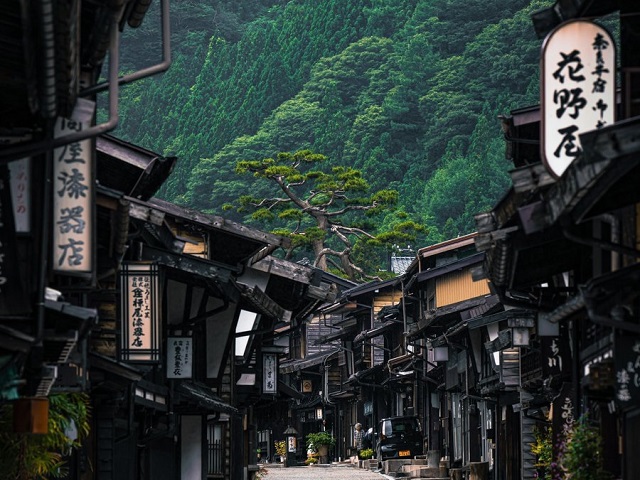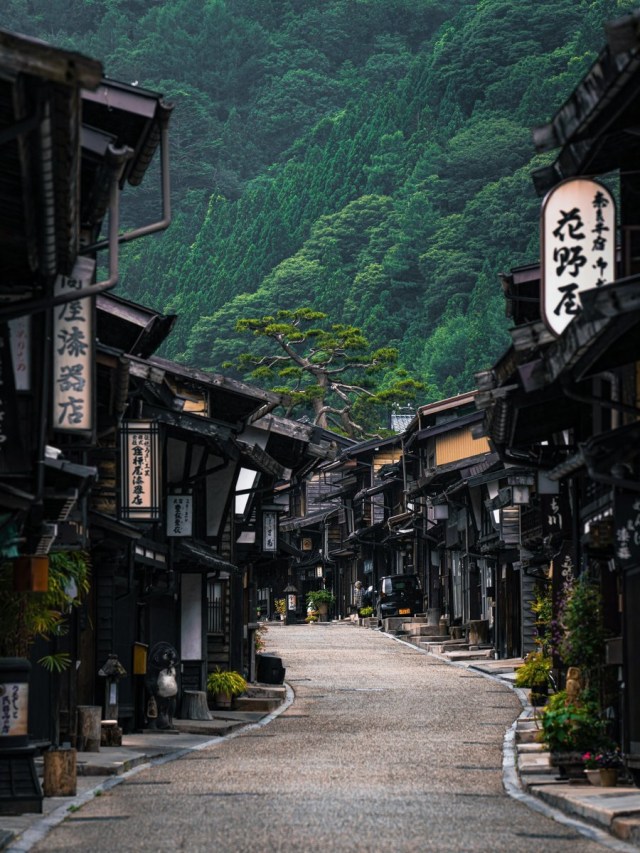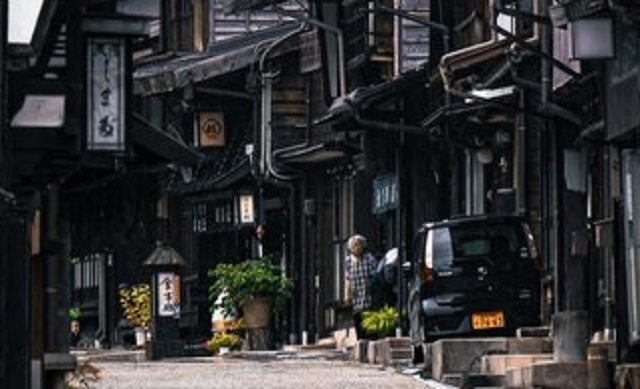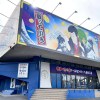
Nagano village was once a major stop on the Kyoto-Edo route, and the neighborhood looks much the same centuries later.
In the early 1600s, following the end of the feudal Sengoku era, the seat of de facto power in Japan moved from Kyoto to Tokyo (or Edo, as it was called in those days). However, while the Shogun took up residence in Tokyo, the Emperor stayed behind in Kyoto, and so both cities continued to be important political, cultural, and commercial centers of Japanese society.
This meant a steady stream of people flowed between the two towns, prompting the development of official semi-maintained overland routes between Kyoto and Tokyo. Since wheeled transportation was prohibited (picture any samurai movie in your head, and realize you hardly ever see people riding around in animal-drawn carts), most made the journey on foot, and since you can’t walk all the way from Kyoto to Edo in a day, a number of shukubamachi, or post towns, sprang up as inns, tea houses, and other facilities were built to accommodate travelers.
Of course, wheeled transportation, whether by train, bus, or private car, is how people today go between Tokyo and Kyoto, so many of the post towns have disappeared or thoroughly modernized. The past isn’t an intangible memory, though, but remains part of the current architecture in the town of Shiojiri, Nagano Prefecture, as this breathtaking photo from Japanese photographer and Twitter user @Hisa0808 (ag.lr.88 on Instagram) shows.
“This post town in Nagano is totally the Edo Period,” tweets @Hisa0808, and it’s hard to argue. The traditional exteriors all look like the sort of place a sandal-sore pilgrim, peddler, or samurai might have stepped into for a hot meal or place to sleep hundreds of years ago.
長野県の宿場町がもはや江戸時代。 pic.twitter.com/PaowMLxMMM
— Hisa (@Hisa0808) May 11, 2021
A few subtle details really help preserve the historical aura of this part of Shiojiri, which is known as Narai-juku. First, the local businesses have seemingly settled on brushstroke fonts and enclosed light sources for their signs, giving them the outward appearance of candlelit lanterns. Second, though as a modern city residents obviously want the convenience of electricity, Narai-juku doesn’t have exposed, above-ground powerlines, going to the extra expense for aesthetics (a decision not every town in Japan makes).
Reactions to @Hisa0808’s photo have included:
“Wait, you took this now, in the present?”
“I hope they’ll always keep the town looking like this.”
“It looks like a painting.”
“Well, now I know where I’m going on my next trip!”
Other photos tweeted in response show how atmospheric Narai-juku looks at night…
奈良井宿いいですよね。前に行って良かったので、また行きたいと思ってます。 pic.twitter.com/irpgyok2Qh
— じゃりてん (@jarite_n) May 11, 2021
…and how little it’s changed in the last 100-plus years.
雰囲気的に何も変わってないですよね~。( ´ー`) pic.twitter.com/QUTy9hyzo8
— ピトフーイ (@PT_mmtm) May 11, 2021
Oh, and if the mountains look particularly beautiful, that might be because Narai-juku is one of the highest-elevation points on the Nakasendo, the more inland route between Kyoto and Edo. Still, don’t let them distract you from noticing the local grannie who makes an appearance in @Hisa0808’s photo.
And if this has you too planning a trip to see Nara-juku for yourself someday, don’t forget that @Hisa0808 has also shown us just how awesome Nagano’s best castle is.
Source, images: Twitter/@Hisa0808
● Want to hear about SoraNews24’s latest articles as soon as they’re published? Follow us on Facebook and Twitter!
Follow Casey on Twitter for more reasons Nagano is awesome.



 Amazing photos of off-the-beaten-path Japanese castles to add to your travel wish list【Photos】
Amazing photos of off-the-beaten-path Japanese castles to add to your travel wish list【Photos】 Hey, have you eaten the news? – Japanese “noodle newspaper” comes with writing on the soba
Hey, have you eaten the news? – Japanese “noodle newspaper” comes with writing on the soba 7 incredible Japanese destinations that tourists haven’t discovered yet
7 incredible Japanese destinations that tourists haven’t discovered yet “Miraculous” cloud over Mt Fuji stuns the Internet
“Miraculous” cloud over Mt Fuji stuns the Internet The most popular places in Japan for viewing sakura in 2024, according to local travel agency
The most popular places in Japan for viewing sakura in 2024, according to local travel agency How to order snacks on a Shinkansen bullet train in Japan
How to order snacks on a Shinkansen bullet train in Japan Burger King Japan suddenly adds Dr. Pepper and Dr. Pepper floats to its menu nationwide
Burger King Japan suddenly adds Dr. Pepper and Dr. Pepper floats to its menu nationwide Demon Slayer: Kimetsu no Yaiba gets new roller coaster attractions and food at Universal Studios Japan
Demon Slayer: Kimetsu no Yaiba gets new roller coaster attractions and food at Universal Studios Japan Japan’s new difficult-to-drink-from beer glass protects your liver, but it’s a brutal experience
Japan’s new difficult-to-drink-from beer glass protects your liver, but it’s a brutal experience Hello, cosmetics! Clinique teams up with Hello Kitty this summer for first-time collaboration
Hello, cosmetics! Clinique teams up with Hello Kitty this summer for first-time collaboration Nintendo history you can feel – Super NES, N64, and GameCube controllers become capsule toys
Nintendo history you can feel – Super NES, N64, and GameCube controllers become capsule toys Studio Ghibli releases Ponyo donburi bowl to bring anime ramen to life
Studio Ghibli releases Ponyo donburi bowl to bring anime ramen to life A visit to the best UFO catcher arcade in the universe!
A visit to the best UFO catcher arcade in the universe! New samurai glasses are Japan’s latest weird must-have souvenir
New samurai glasses are Japan’s latest weird must-have souvenir New Japanese banknotes selling online for up to 40 times original value
New Japanese banknotes selling online for up to 40 times original value “The most Delicious Cup Noodle in history” – Japan’s French Cup Noodle wins our heart【Taste test】
“The most Delicious Cup Noodle in history” – Japan’s French Cup Noodle wins our heart【Taste test】 Starbucks releases a cute Frappuccino and Unicorn Cake…but not in Japan
Starbucks releases a cute Frappuccino and Unicorn Cake…but not in Japan Kyoto Tower mascot termination reveals dark side behind cute Japanese characters
Kyoto Tower mascot termination reveals dark side behind cute Japanese characters McDonald’s Japan’s Soft Twist Tower: A phantom ice cream only sold at select branches
McDonald’s Japan’s Soft Twist Tower: A phantom ice cream only sold at select branches Yabai Ramen: What makes this Japanese ramen so dangerous?
Yabai Ramen: What makes this Japanese ramen so dangerous? Finally! Nintendo Japan expands Switch 8-bit controller sales to everybody, Online member or not
Finally! Nintendo Japan expands Switch 8-bit controller sales to everybody, Online member or not Japanese government wants to build luxury resorts in all national parks for foreign tourists
Japanese government wants to build luxury resorts in all national parks for foreign tourists To combat declining birth rate, Japan to begin offering “Breeding Visas” to foreigners
To combat declining birth rate, Japan to begin offering “Breeding Visas” to foreigners 10 things you should buy at 7-Eleven in Japan
10 things you should buy at 7-Eleven in Japan Studio Ghibli releases anime heroine cosplay dresses that are super comfy to wear
Studio Ghibli releases anime heroine cosplay dresses that are super comfy to wear Woman charged for driving suitcase without a license in Osaka
Woman charged for driving suitcase without a license in Osaka Studio Ghibli unveils My Neighbour Totoro miniature house model
Studio Ghibli unveils My Neighbour Totoro miniature house model Kyoto experiencing problems with foreign tourists not paying for bus fares, but not on purpose
Kyoto experiencing problems with foreign tourists not paying for bus fares, but not on purpose Fighting mild hunger with a Japanese soda that turns into jelly in the stomach【Taste test】
Fighting mild hunger with a Japanese soda that turns into jelly in the stomach【Taste test】 Studio Ghibli’s Howl’s Moving Castle tapestry unveiled in Japan for first time
Studio Ghibli’s Howl’s Moving Castle tapestry unveiled in Japan for first time McDonald’s new Happy Meals offer up cute and practical Sanrio lifestyle goods
McDonald’s new Happy Meals offer up cute and practical Sanrio lifestyle goods Sales of Japan’s most convenient train ticket/shopping payment cards suspended indefinitely
Sales of Japan’s most convenient train ticket/shopping payment cards suspended indefinitely Sold-out Studio Ghibli desktop humidifiers are back so Totoro can help you through the dry season
Sold-out Studio Ghibli desktop humidifiers are back so Totoro can help you through the dry season Japanese government to make first change to romanization spelling rules since the 1950s
Japanese government to make first change to romanization spelling rules since the 1950s Foreigner’s request for help in Tokyo makes us sad for the state of society
Foreigner’s request for help in Tokyo makes us sad for the state of society Ghibli founders Toshio Suzuki and Hayao Miyazaki contribute to Japanese whisky Totoro label design
Ghibli founders Toshio Suzuki and Hayao Miyazaki contribute to Japanese whisky Totoro label design Doraemon found buried at sea as scene from 1993 anime becomes real life【Photos】
Doraemon found buried at sea as scene from 1993 anime becomes real life【Photos】 Tokyo’s most famous Starbucks is closed
Tokyo’s most famous Starbucks is closed Princesses, fruits, and blacksmiths: Study reveals the 30 most unusual family names in Japan
Princesses, fruits, and blacksmiths: Study reveals the 30 most unusual family names in Japan Sword of one of Japan’s last samurai discovered in house in America
Sword of one of Japan’s last samurai discovered in house in America Japanese photographer captures the beauty of Kyoto in the snow 【Photos】
Japanese photographer captures the beauty of Kyoto in the snow 【Photos】 Fight like a ninja in a samurai town, with sword-fighting experience at Kyoto Toei movie studio park
Fight like a ninja in a samurai town, with sword-fighting experience at Kyoto Toei movie studio park This hotel in the mountains of Japan has an awesome hi-tech ski/snowboard simulator【Videos】
This hotel in the mountains of Japan has an awesome hi-tech ski/snowboard simulator【Videos】 Pork or beef? A peek into how Japan’s curry preferences change from place to place
Pork or beef? A peek into how Japan’s curry preferences change from place to place Sacred 1,200-year-old tree toppled by severe storm at shrine in central Japan【Photos】
Sacred 1,200-year-old tree toppled by severe storm at shrine in central Japan【Photos】 We try out the delicious, fluffy milk bread featured in the Japanese anime movie Your Name
We try out the delicious, fluffy milk bread featured in the Japanese anime movie Your Name What pandemic? Onsen towns, hiking trails and theme parks packed with crowds on four-day weekend
What pandemic? Onsen towns, hiking trails and theme parks packed with crowds on four-day weekend New York Times makes a surprising pick for the best city to visit in Japan
New York Times makes a surprising pick for the best city to visit in Japan “Amazing Kyoto” shows us sides of Japan’s old capital we’ve never seen before — in two languages!
“Amazing Kyoto” shows us sides of Japan’s old capital we’ve never seen before — in two languages! Japan Travel: What it’s like to go on a solo journey on a Japanese restaurant train
Japan Travel: What it’s like to go on a solo journey on a Japanese restaurant train This amazing photo of the Japan Alps only gets more beautiful the higher you look
This amazing photo of the Japan Alps only gets more beautiful the higher you look Pre-dawn photo of Mt. Fuji looks almost too beautiful to be real
Pre-dawn photo of Mt. Fuji looks almost too beautiful to be real Free magazine shows us Japanese grandpas and grannies who are rocking this age thing
Free magazine shows us Japanese grandpas and grannies who are rocking this age thing Photos of “everyday life” in the town next to Mt. Fuji look like a beautiful fantasy world
Photos of “everyday life” in the town next to Mt. Fuji look like a beautiful fantasy world
Leave a Reply